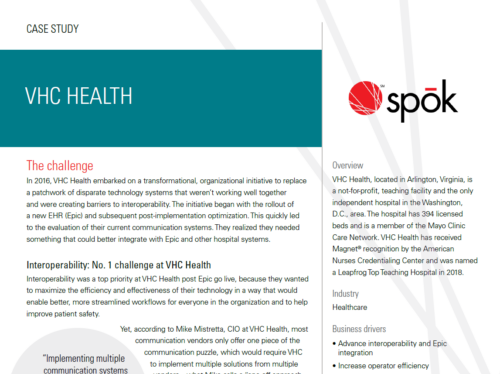Case studies
VHC Health
Overview
VHC Health, located in Arlington, Virginia, is a not-for-profit, teaching facility and the only independent hospital in the Washington, D.C., area. The hospital has 394 licensed beds and is a member of the Mayo Clinic Care Network. VHC Health has received Magnet® recognition by the American Nurses Credentialing Center and was named a Leapfrog Top Teaching Hospital in 2018.
Industry
- Healthcare
Business drivers
- Advance interoperability and Epic integration
- Increase operator efficiency
- Streamline clinical workflow
- Improve communication and care coordination between clinicians and other hospital staff
- Allow clinicians to securely send protected health information
Solution
- Spok® console, on-call scheduling, and web directory
Results
- Increased operator productivity by eliminating paper-based on-call schedules
- Saved operators time and prevented laborious search tasks by integrating patient information
- Automated notifications to meet The Joint Commission Standard CTS.04.03.33
The challenge
In 2016, VHC Health embarked on a transformational, organizational initiative to replace a patchwork of disparate technology systems that weren’t working well together and were creating barriers to interoperability. The initiative began with the rollout of a new EHR (Epic) and subsequent post-implementation optimization. This quickly led to the evaluation of their current communication systems. They realized they needed something that could better integrate with Epic and other hospital systems.
Interoperability: No. 1 challenge at VHC
Interoperability was a top priority at VHC Health post Epic go live, because they wanted to maximize the efficiency and effectiveness of their technology in a way that would enable better, more streamlined workflows for everyone in the organization and to help improve patient safety.
Yet, according to Mike Mistretta, CIO at VHC Health, most communication vendors only offer one piece of the communication puzzle, which would require VHC Health to implement multiple solutions from multiple vendors—what Mike calls a “one-off approach that limits interoperability” and inhibits the options to share data and functionality with hospital systems key to clinical workflows. “We were looking for a single vendor that understood the benefits of extracting clinical information from the EHR to drive faster, more efficient decision-making for clinicians,” explains Mistretta.
Implementing multiple communication systems from multiple vendors isn’t a good strategy. That one-off approach is what limits interoperability.
– Mike Mistretta, CIO, VHC Health
The solution
VHC Health leaders selected the Spok Care Connect® platform to accompany their EHR and modernize their communication processes. Using the Spok integration with Epic, VHC Health has streamlined patient admit, discharge, and bed turnover processes. Now, when a bed is empty, Spok detects the Admit Discharge and Transfer event and triggers workflow actions. Cleaning services receives a notification and quickly prepares the room for the next patient, resulting in more efficient use of resources.
VHC Health is using the same functionality to improve patient admissions. Upon admission, an ADT event triggers a notification to the charge nurse assigned to that floor, letting the nurse know about the new admit so he/she can prepare for the patient’s arrival.
Operators access patient information with Epic-Spok integration
Debra Oliver, director of communications, manages the call center and answering service at VHC and has been heavily involved with the implementation of Spok solutions. “The operational and clinical workflow improvements we’ve made using Spok are impressive,” says Oliver. “We’ve achieved a lot in a short amount of time.”
VHC Health leveraged Epic-Spok integration to include patient information in the central directory. This enables operators to have immediate access to patient information—where previously, all patient information calls were transferred to the main desk. According to Oliver, this has been a huge time saver for operators and helps them deliver a higher level of customer service.
Eliminating paper-based on-call schedules
Another huge milestone at VHC Health was the elimination of paper-based on-call schedules. These printed schedules quickly became outdated and it was never clear if someone was looking at the most current version. Using Spok, there’s one place to update schedules for the entire hospital, and staff know who to contact.
Neuroscience division automates EEG orders
The neuroscience division at VHC Health is leveraging Spok solutions to streamline the process of EEG (electroencephalogram) orders. Prior to using Spok, the EEG director would receive all messages for EEG orders, then forward them to the right person by referencing the paper-based on-call schedule. VHC Health has drastically improved this workflow by using Spok to automatically send the order from Epic to whoever is on call at that time. The director no longer spends valuable time determining who is on call and forwarding messages.
Everyone has visibility to on-call schedules and can easily determine who they need to contact.
– Debra Oliver, Director of Communications, VHC Health
The result
Increasing operator efficiency while delivering better service
The contact center has seen the largest efficiency gains. By integrating patient information from Epic into the Spok directory, operators have instant access to patient information. In addition, the elimination of paper-based on-call schedules has helped off-load a significant number of calls operators received. “Everyone has visibility to on-call schedules and can easily determine who they need to contact,” explains Oliver. “Operators handle significantly fewer calls to confirm who’s on call.”
Adhering to The Joint Commission Standard CTS.04.03.33
VHC Health is using Spok to notify staff if the temperature of refrigerators is outside the minimum or maximum range. “Each unit has identified a text-to-pager for these notifications,” explains Oliver. “It may seem like a small workflow adjustment, but it’s something we can easily automate and our clinical teams appreciate getting this time back.”
According to Charles Fletcher, Vice President of Support Services, the most significant benefit they’ve experienced is increased staff efficiency and productivity. “Using Spok solutions, the opportunity exists to consolidate, streamline, and simplify,” says Fletcher. “In order for the organization to benefit from technology, we must improve processes and eliminate institutionalized workarounds. Spok makes that possible.”




